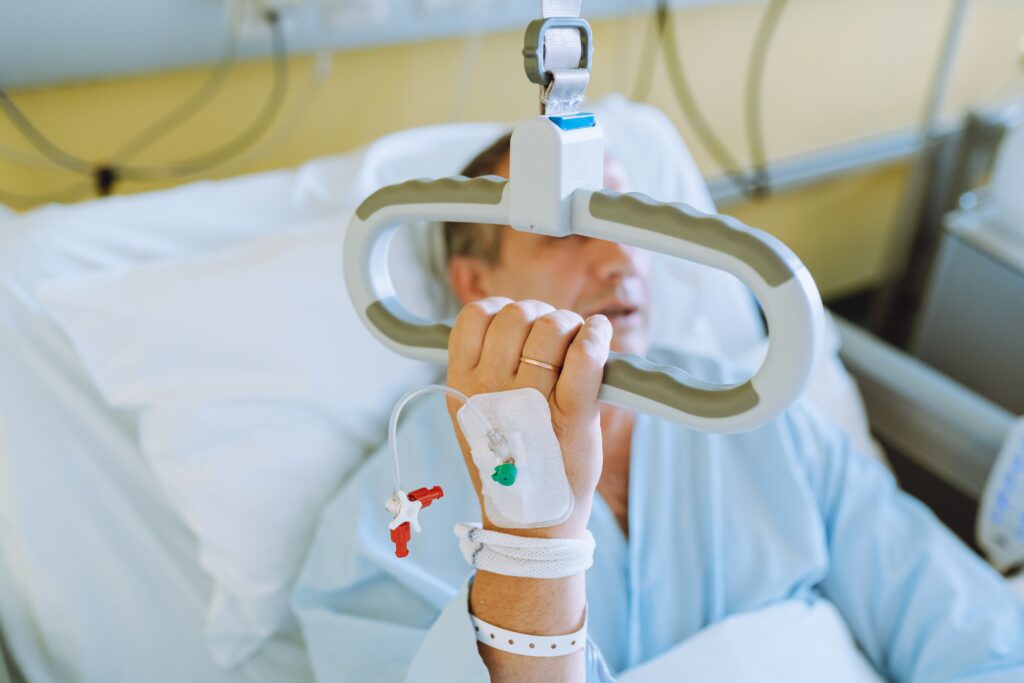At Maimonides Medical Center, efforts to improve patient mobilization are underway hospital-wide, thanks to the collaborative efforts of our rehabilitation, occupational therapy, physical therapy, and nursing teams. For patients recovering in the Surgical Intensive Care Unit (SICU), this initiative is especially important in preparing for their return to regular activity and life post-surgery.
There, occupational therapists began collaborating with medical, nursing, and respiratory therapy staff two years ago to identify patients on mechanical ventilators who could benefit from early mobilization, with the objective of limiting the muscle loss, mobility issues, medical complications, and other effects of extended bed confinement. Collaboration with physical therapists was also incorporated as the program developed.
Luis F. Riquelme, PhD, Consulting Director of Rehabilitation & Speech-Language Pathology, says speech pathologists often go into intensive care units for consultations with patients when extubation causes swallowing or communication challenges. Consults initiated with occupational and physical therapists with patients before extubation were rare. Now, that’s changed.
“We’re seeing more patients in the SICU, and we’re seeing them early on, which has major benefits in terms of a quicker return to their previous quality of life,” Dr. Riquelme says.
Today, occupational and physical therapy consults in the SICU occur regularly to improve functional outcomes and increase patients’ independence. Some studies and anecdotal evidence suggest that early mobilization also¹ ²:
- Reduces length of stay in the ICU
- Prevents complications such as pressure ulcers
- Builds muscle strength and endurance
- Improves cardiovascular performance
- Improves overall mental well-being and alertness
“Most patients, unless they’re coming in for an elective procedure, probably don’t plan on being in the hospital,” says Veldin Corbo, OTR/L, senior occupational therapist at Maimonides Medical Center. “We want to get them back to their usual selves, to their highest level of independence, as soon as possible.”
Enabling Self-Care and Independence
Early mobilization spans a range of subtle steps that, depending on a patient’s condition, may include:
- Sitting on the edge of the bed
- Brushing teeth
- Upper body/lower body dressing tasks
- Grooming and cleaning themselves
- Reaching for items
- Writing or using a laptop at the edge of the bed
- Standing or walking, when appropriate
“Mobilization is a bridge between self-care and independence,” Corbo says. “Whether a patient was in the ICU, step-down unit, or a regular general medicine unit, it’s when we get a head start that has proven to speed things along and help the patient in the long run.”
OT Initiates Early Mobilization within the SICU
Gerard Betro, MD, Maimonides SICU Director and critical care surgeon, first became interested in the concept of early mobilization after reading about Post-Intensive Care Syndrome (PICS) back in 2012.
“I was captivated by the idea that the long-term, chronic effects of critical illness survivorship could potentially be mitigated by a number of interventions initiated while still a patient in the ICU,” he said.
The most intriguing and revolutionary intervention was early mobilization (EM). Upon attending the first annual Critical Care Rehabilitation Conference at The Johns Hopkins Hospital, Dr. Betro learned about how different rehabilitation specialists could be integrated into traditional multidisciplinary care teams.
“It was so inspiring to see how various professionals worked together to engage the patients with activity levels not normally seen in ICU patients,” he said. “The benefits were obvious for everyone involved—patients, medical staff, and families.”
To make early mobilization a reality in the Maimonides SICU, senior leadership across disciplines was required.
“Fortunately, here at Maimonides, we have patient-centered, forward-thinking clinical leaders including our SICU Nurse Manager Anzhela Dupliy, MSN, RN, SCRN, and Dr. Riquelme, who supported early mobilization efforts in the unit. Assigning a dedicated SICU rehabilitation liaison for emergency medicine was a key step in operationalizing the initiative,” says Dr Betro.
Sean Murray, OTR/L, senior occupational therapist, became the first SICU rehabilitation liaison, serving on the Rehabilitation Mobilization Committee and providing leadership on the initiative. He was intrigued by opportunities in the SICU among patients with a range of post-surgical trauma from sepsis, serious infections, neurosurgeries such as craniotomies and craniectomies, and interventional radiology and oncology procedures.
Supported by Dr. Betro, Murray began attending weekly rounds with medical staff.
“I was going from room to room, patient to patient, listening to their medical status, why they’re in the SICU, and what support they’re requiring,” Murray says.
Then, he, Dr. Betro, and the medical team of attending physicians, resident physicians, nurses, and respiratory therapists began to determine which patients could benefit from therapy to help kickstart their recovery process.
Addressing Fears with Education and Collaboration
Addressing fears that mobilization can put patients at risk has been critical to occupational therapy playing a larger role in SICU patient recovery. The addition of a portable sit-to-stand lift has helped address those concerns, along with supportive collaboration from nursing and respiratory care teams who help occupational therapists gain a full picture of each patient’s unique condition and challenges.
“The fear has always been that these patients are connected via tubing to mechanical ventilation, as well as IVs and monitors,” Dr. Riquelme says. “So, it’s important for the rehab team to understand what that means and how far they can go.”
Corbo adds that not every intensive care patient is a candidate for early mobilization.
“It takes a collaborative effort to identify those patients, and that’s when we go in and evaluate the patient in conjunction with the ICU team, nurses, respiratory therapists, and physicians, to establish a plan as a team.”
“It’s a program we’re planning to take to other critical care units in the hospital,” Dr. Riquelme adds.
For more information on critical care and occupational therapy at Maimonides Health, visit our Orthopedic Services and Procedures, Rehabilitation, and Critical Care services. You may also reach the Rehabilitation Gym at (718) 283-6418 or contact Alexandra Soyfer, Director, Rehabilitation & Speech-Language Pathology at (718) 283-7534.




